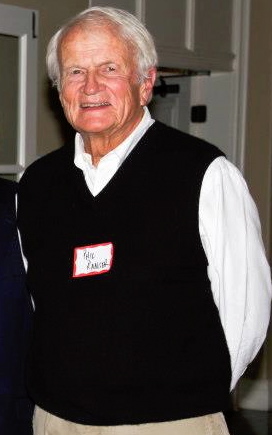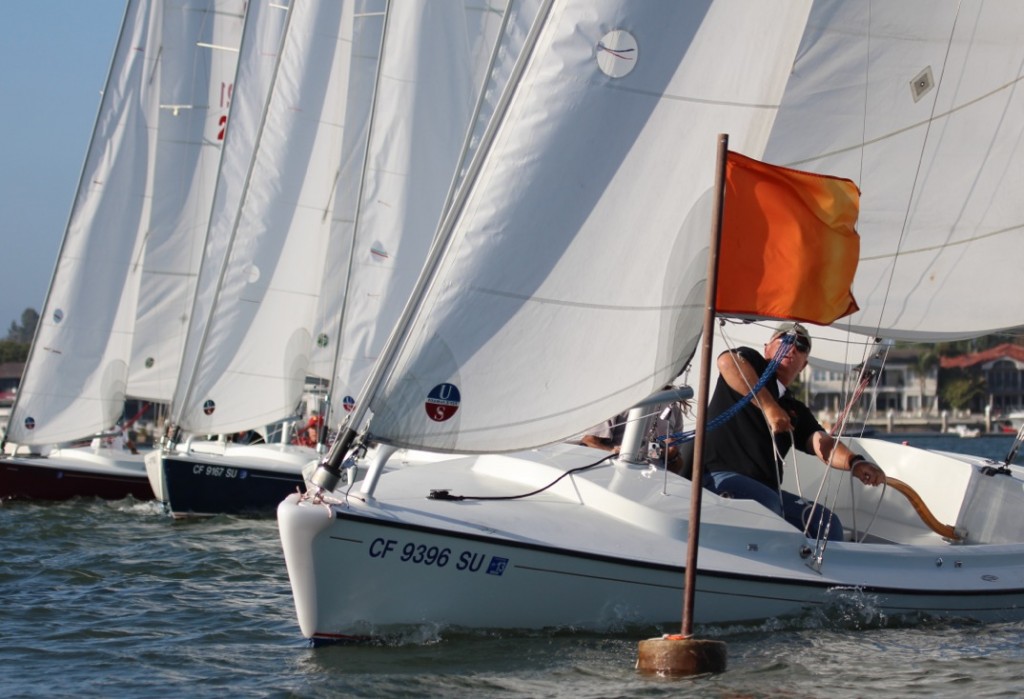I took my Harbor 20 for a daysail out of the harbor and it turned into a nightmare faster than I could imagine.
We left the dock on Saturday November 10, 2012, around 9:30 a.m. in “Old Glory” #21 without leaving a log or telling anyone, being novice sailors with plans to stay close to the harbor. It was a clear day with windier than normal conditions. We didn’t see the posted small craft advisory at Harbor Patrol, didn’t think much of passing sailboats coming back from a cancelled regatta, or the missing bait barge at the harbor entrance. We even waved to one of the harbor patrol on their boat on our way out of Newport Harbor.
It was very easy to go downwind in a westerly towards Laguna Beach. When the wind picked up, we decided to turn around somewhere around Crystal Cove/Reef Point (Scotchman’s Cove). At first, we were making progress back until we got to around Little Corona Del Mar Beach.
The current, wind and swells made it impossible to clear the harbor entrance, and my goal at that time was to steer away from the rocks. It was really hard to steer and the rudder was out of the water often. I was exhausted trying to position the boat at the proper angle to make it through each of the endless waves. Therefore, we changed tack and so went further out to sea for awhile until we were at least 200 meters out to sea from Little Corona Del Mar Beach. However, the waves got bigger, and the rolling worsened with the higher wind as I depowered the sails.
The first 8-10 foot wave hit us, as the wind overpowered the ability of the rudder to maintain a straight course, and we rounded up. The boat headed up into the wind, causing us to slow down and stall out and I was no longer able to control the direction of the boat. A subsequent gust knocked our bow over and forced us parallel to the wave, which put the low-freeboard leeward side into the water. The cabin filled halfway with water and we lost steering and maneuverability, since we were now bow heavy with hundreds of gallons of water and sitting significantly lower in the water. There was too much water to bail with a 2 gallon bucket or bilge pump. At that point my crew, Stewart, pulled lifejackets out from below and strung them together with the bumpers to create maximum flotation. I said “OMG we’re sinking” and called channel 16 and repeated a mayday message three times since I wasn’t sure anyone heard and there was no time to confirm. The second wave completely filled the cabin with water. In 1-2 minutes, with my hand still on the tiller, we were suddenly in the ocean.
We swam away and were lucky to avoid getting tangled in any lines and dragged down with the boat. We looked back at the Harbor 20 and saw only 5 feet of mast that was left go straight down. Wallets, purse, three cell phones and fishing gear were all lost. I went under the surface twice and drank some water. It crossed my mind it would be really impossible to see two bobbing heads in large swells. Stewart pulled the flotation and lifejackets from the cabin as we sank and I grabbed a lifejacket and hung on since it is nearly impossible to swim in sneakers, jacket and jeans. Stewart, a former triathlete and surfer, felt at home in the large swells and held my head above water.
We had spotted a crew team in a big outrigger canoe in the near distance rowing away. We yelled and they finally asked if we needed help and Stewart yelled “Yes!” They hung back to avoid getting dragged down. We swam about 50 feet in 59 degree water to the outrigger. The crew team pulled us on board and one of the members held on to me. Stewart was seated at the front of the outrigger and the coach gave him crew lessons. We were met at the harbor entrance by the Newport Harbor Patrol, who said they heard a distress call–something about a Harbor 20 going down. However, by the time they were looking, there was no Harbor 20 to spot and they were pointed in the wrong direction further inland than where we sank to search for us. The outrigger disappeared after dropping us off and, if it weren’t for them, Stewart and I would have been tortured to try to swim more than 200 meters to shore. The ocean was cold and every minute counted; we were hypothermic, with soaking wet clothes. It took at least 30 minutes to warm up enough in the hot harbor patrol shower and harbor patrol sweats for me to feel my fingers and stop shivering.
“Old Glory” went down with her glorious sails up and we haven’t found her yet, despite multiple Vessel Assist grid searches a few days later. Who knows, perhaps someday she will return from her voyage. It could have been us along with her, never to be found. Even though it was a horrifying learning experience and a great loss to lose dear #21, I am still a big fan of the Harbor 20. I supposedly purchased Hull #40, which was really Hull #1, a perfect bonus for a traumatic event and coincides nicely with the 15th Anniversary of the Harbor 20.
Harbor 20 sailors need to take safety seriously and know beforehand how to handle and be prepared for the worst situations, even if they plan to use their “Harbor” 20 mostly in the harbor. Things can go wrong really fast and unexpectedly with no time to think or panic sets in. Hopefully, knowledge and experience can prevent or mitigate the actual accident.
In summary, I feel these are important safety issues:
(1) Weather: Check the weather and don’t underestimate it. If necessary, stay home and don’t put yourself at risk in the first place. Check warnings posted at harbor patrol. We didn’t know it was Santa Ana conditions until later. We probably would have done better running before the storm to shore in the direction of Dana Point (that did occur to me during the incident) and wait out the weather. It’s also a bad sign when not that many other boats were out sailing and regattas were being cancelled.
(2) Log: Log book your trip or tell someone before leaving.
(3) Swim: Know how to swim. Wear swimmable or easily strippable shoes and clothes.
(4) Lifejacket: Wear your lifejacket. Whistle on life jacket would be useful. Consider EPIRB/PLB-like device.
(5) Boat flotation: Flotation wasn’t offered as an option on Harbor 20s until hull number 150, and wasn’t routinely installed until number 320. Since the boat has a 900 lb. keel and 1800 lb. displacement, it sinks like a rock without flotation. Stuffing the cushions under the cabin top would not be enough useful flotation.
(6) Radio: Have radio, know what to say and length of transmission. One needs to transmit longer and repeat message several times so they have a better chance of hearing. Even though I repeated three times, they hardly heard one garbled message. Some radios, like the one I was using, don’t have programmed GPS, and you would need to transmit long enough for Long Beach Coast Guard to get three GPS coordinates. They got one bearing since my transmission was less than a minute. One bearing can vary by several degrees and would cover an area of 40 miles more or less.
(7) Phone/contacts: Have Coast Guard, Harbor Patrol, Seatow, Vessel Assist, etc. numbers handy. Waterproof your cell phone and have handy.
(8) Safety equipment: Paddle, flares, bailing bucket etc.
(9) Boat Maintenance: Have motor and bilge pump working, keep batteries charged, etc.
(10) Sailing/seamanship skills: Know how put in a reef. Know how to anchor, heave to, go over waves. Man overboard skills. Extra line for jury rigging in case rig fails and for towing.
(11) Medical awareness: Learn about hypothermia.
(12) GPS: GPS device would be useful to mark your course, since it’s hard to estimate distance, and can be used to mark the spot right away where you sank. Also, search ASAP. We started searching several days later, possibly giving the boat time to fall off the continental shelf.


